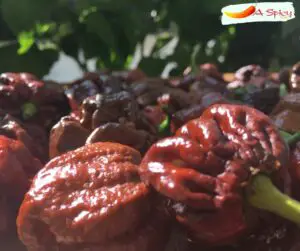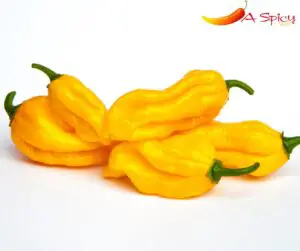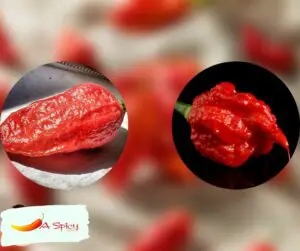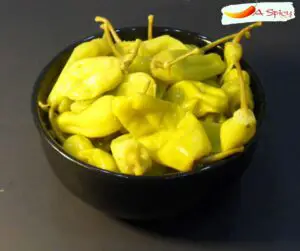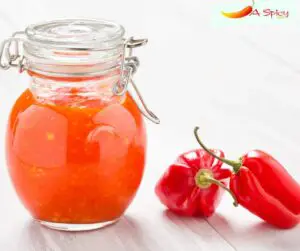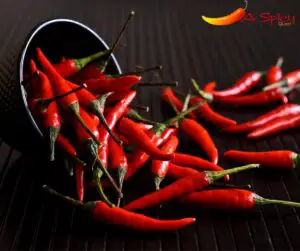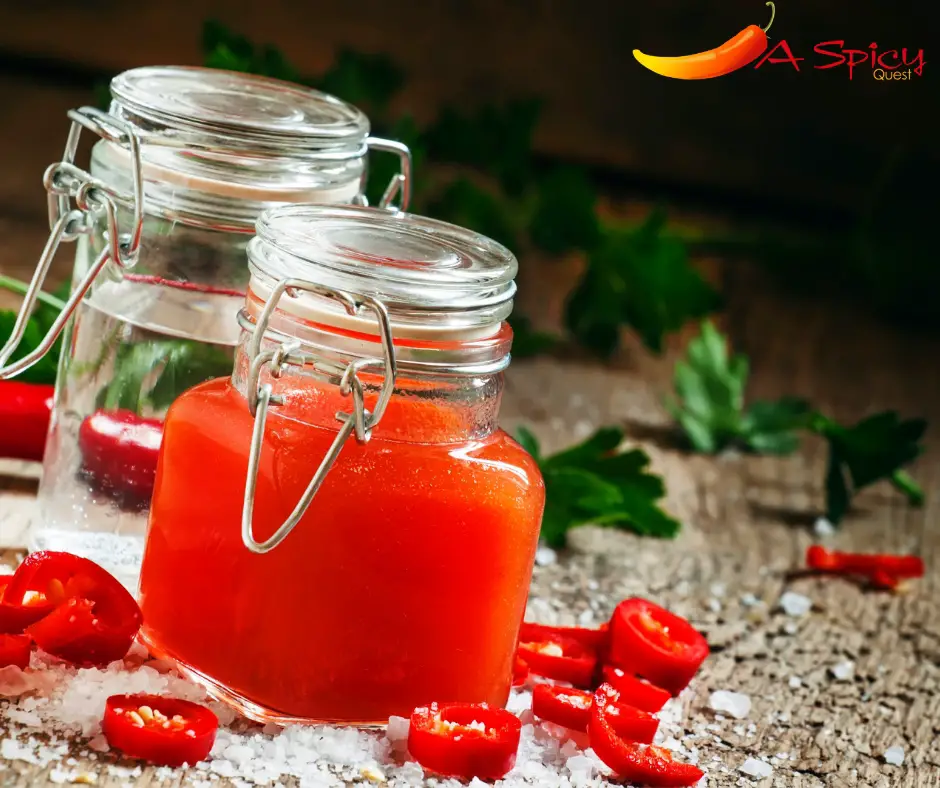
For those who are familiar with the taste of Tabasco sauce, you will notice that it is packed full of pepper. What kind of peppers are used in Tabasco sauce? It’s a familiar question and one which many people have asked. In this post, we’ll cover the types of peppers that were used to create the single most well-known hot sauce in the world, Tabasco sauce.
The Tabasco pepper is used in Tabasco sauce. It was named for the location where it was first cultivated in the Mexican state of Tabasco. The hotness of the pepper comes from capsaicin, which is found in the seeds and white veins of the fruit. This makes it an ideal pepper to use for hot sauces like Tabasco, which contain some 40% tabasco peppers.
About Tabasco Pepper
Tabasco peppers are small, red fruits that can be used to make hot sauces that are used to spice up foods. It is a variety of Capsicum frutescens. It is also known as tabasco pepper, tabasco sauce, tabasco or tabasco chilli. The peppers are named after the Tabasco region of Mexico, where they were first cultivated.
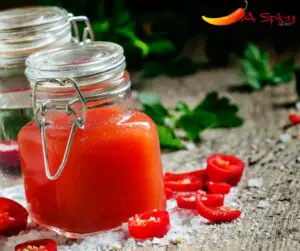
They get their heat from capsaicin, which is a chemical compound found in chili peppers. The tabasco pepper plant grows about two feet tall and produces bright red fruits that measure about 1/2 inch in length. The peppers have a thin wall and a round shape with pointed ends. They ripen from green to yellow and then turn orange-red before maturing into dark red with small white seeds inside.
The peppers are made into Tabasco Sauce, which is produced by companies and sold to consumers worldwide. The sauce is made from tabasco peppers, vinegar, and salt. The mash contains capsaicin, which gives the sauce its heat. Tabasco sauces are available in several flavors.
What Are the Three Ingredients in Tabasco Sauce?
Tabasco sauce is made from fully aged red peppers, salt from Avery Island, Louisiana, and high-quality distilled vinegar. The peppers are harvested at the peak of ripeness and then aged in Spanish white oak barrels for up to three years. This aging process yields a rich flavor that adds complexity to the sauce. The famous pepper mash is then combined with vinegar and salt to create the final product.
The mash is ground into a fine powder before it’s added to the other ingredients. There are nine different types of Tabasco sauce available:
Red Pepper Sauce and Green Jalapeno Sauce, Chipotle pepper sauce, Cayenne garlic sauce, Habanero pepper sauce, Sriracha sauce, scorpion sauce, sweet and spicy sauce, and Buffalo-style hot sauce.
All the varieties have the same fiery kick but have slightly different tastes because of their distinct ingredients (red peppers for Red Pepper Sauce and green jalapenos for Green Jalapeno Sauce).
Is Tabasco Made With Cayenne Peppers?
Yes, Tabasco is made with a blend of cayenne peppers, red jalapeo, and vinegar, among other things. That’s right, the spicy condiment that comes in a distinctive green-topped bottle and makes everything taste like salsa. The sauce was first produced by Edmund McIlhenny in Avery Island, Louisiana, in 1868. McIlhenny had recently returned from a trip to Mexico and was inspired by the local cuisine.
He began experimenting with peppers and created a blend of cayenne peppers, red jalapeos, garlic, and vinegar to make his hot sauce. Today, the company produces about 20 million bottles of Tabasco per year.
Each bottle contains about 45 peppers. Tabasco sauce is made from tabasco peppers, which are native to Mexico. The peppers are mashed and aged in oak barrels for three years.
The resulting mash is blended with vinegar to create a thick paste that is aged again to develop its flavor. The finished product has an acidic tangy taste with a hint of spiciness.
What Gives Tabasco Its Flavor?
Tabasco sauce is made by soaking the tabasco peppers (which are a type of pepper known as Capsicum frutescens) in white vinegar for up to three years. The longer they soak, the hotter they get. The peppers are aged for three years in white oak barrels; this process adds a distinctive flavor to the sauce. The longer the peppers are aged, the more flavorful they become.
Red tabasco peppers are first soaked in salt brine for about three days to soften their skins and then placed in white oak barrels for aging. After being rubbed with salt every day for about a month, they are rinsed clean and set aside until they turn red (about two weeks) when they are ground into mash, which becomes what we know as “red” or “regular” tabasco sauce.
Green tabasco peppers are then ground into a mash and combined with the red mash to make what we call “green” or “spicy” tabasco sauce. The finished product is aged in barrels for one year before being bottled.
Which Is Hotter Tabasco or Cayenne?
Tabasco and cayenne peppers both come from the Capsicum genus of plants, but Tabasco is 6 to 10 times hotter than Cayenne. The two hot peppers are not related, but they share many characteristics. Both Tabasco and cayenne peppers are members of the Capsicum genus, which includes hundreds of different types of pepper plants, including bell peppers and jalapenos.
Both Tabasco and cayenne peppers are spicy hot, though Tabasco is much hotter than cayenne. The Scoville scale measures the amount of capsaicin in a pepper. The higher the number on the Scoville scale, the spicier hot it is assumed to be. Tabasco peppers have a rating between 2,500 and 5,000 units on this scale, much lower than that of cayenne, which ranges from 30,000 to 50,000 units.
Health Benefits of Tabasco Pepper
Here are some health benefits of Tabasco Pepper:
Heart Health
The capsaicin present in tabasco pepper helps reduce blood pressure and cholesterol levels by increasing HDL or good cholesterol levels while reducing LDL or bad cholesterol levels in the body. This reduces the risk of heart diseases like atherosclerosis and coronary artery disease.
Diabetes
The capsaicin content present in tabasco pepper helps prevent type 2 diabetes by enhancing insulin sensitivity and regulating blood glucose levels after meals by increasing the secretion of insulin from pancreas cells and also preventing the absorption of glucose from intestine cells by reducing intestinal glucose permeability.
Lowers bad cholesterol levels and blood pressure
The capsaicin in Tabasco pepper helps lower bad cholesterol levels in the body by increasing bile production and reducing triglycerides in the bloodstream. This makes it easier for your body to absorb nutrients from food, thereby reducing high blood pressure levels as well as heart disease risk factors such as high cholesterol levels or diabetes risk factors such as insulin resistance or abnormal glucose tolerance test results that are associated with metabolic syndrome (MetS).
Final Word
So if you are looking to spice up your cooking, look no further than Tabasco sauce. It is perfectly safe, and maybe even beneficial, to use in your meals (just a few shakes). However, we don’t recommend drinking it as it might be a bit too spicy for most.

